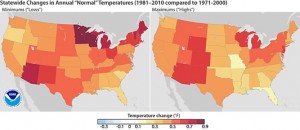
Standards were changed when new climate normals for the United States were produced by the National Oceanic and Atmospheric Administration’s National Climatic Data Center (NCDC) this July.
The U.S. climate normals are a set of average temperatures that define the normal weather for an area. They are based upon average weather information gathered in the past 30 years across the country.
The set of data published earlier this month was based on averages from 1981 to 2010, and includes measurements of monthly and daily maximum temperatures, monthly and daily minimum temperatures, daily and monthly precipitation and snowfall statistics, and daily and monthly heating and cooling degree days.
Though each state varied in their change in temperatures, researchers discovered an overall warming across the United States.
According to the new data, temperatures across the country are approximately 0.5 degrees Fahrenheit warmer than the last data produced ten years ago. Temperatures in California are expected to increase about 0.4 degrees Fahrenheit.
“The information helps people understand what conditions they can expect wherever they may live,” according to Jennifer Freeman of the American Meteorological Society.
Calculation methods for arriving at climate normals throughout the world have remained consistent since the 1930s, proving the data reliable, according to the NOAA’s website.
These new climate normals link together warming patterns that many have already been noticed, such as a distinct warming trend, an increase of pests due to warmer winters, a longer fire season, a shift of plants moving northward and changing pollination patterns.
All of these patterns have a profound effect on the environment we live in, though researchers continue to map out what those specific effects might be.
The NCDC will continue to publish additional data in the next few months, including agricultural normals and population-weighted normals.
There are several other reports published as well as studies still being done that also consider rising average temperatures, in addition to the NOAA’s recent publication.
The International Panel on Climate Change (IPCC) is due to publish its fifth assessment report, which “will provide an update of knowledge on the scientific, technical and socio-economic aspects of climate change” according to the IPCC’s website, in either 2013 or 2014.
Also, Stanford scientists Noah Diffenbaugh and Martin Scherer produced a study earlier this May, predicting the increase of temperatures across the United States over the next twenty to sixty years.
The study alluded to the fact that a higher average temperature will soon be the norm. It predicted the severe consequences that the temperature shift will have on human health, agricultural production and ecosystem productivity.
“The fact that we’re already seeing these changes in historical weather observations, and that they match climate model simulations so closely, increases our confidence that our projections of permanent escalations in seasonal temperatures within the next few decades are well founded,” Diffenbaugh said.
As of yet this new data of increasing temperature has had little effect on policymakers in the United States, though this might change once more data and reports on findings are produced and verified in their claims of climate change’s effect on humans.











